
Saturday 4th October Into Bulgaria 45 miles
We soon came to the village of Durankulak, and went into a small supermarket where we were able to get a loaf of bread and some tomatoes, pears and ham. We also got some Bulgarian cheese, but initially the cashier was going to give us the whole large piece! Outside was an ATM – Adrian was delighted to get more money so easily, with the instructions in English.
We travelled on a road with a good surface, through flattish land with large fields, looking rather English!
We turned off to the sea at Sabla, and now we had really badly surfaced roads. We stopped above the sea for lunch, looking to a derelict lighthouse and pier. The sea looked blue, but outside it was windy.
We drove on to Kaliakra Nature Reserve on a good road. This cost 3 lev each , just over £1. Adrian asked if there was a rate for oldies. The man said 'Yes. 6 lev for two.'! 'You go big car park. Stop car. Walk'. So that's what we did! Cape Kaliakra is a long peninsula jutting out into the sea, high above the cliffs - no beaches in this area!
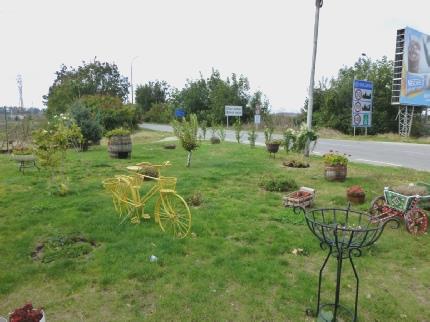
At the Romanian/Bulgarian border
The reason to come here is to see wildlife – it is on a bird migratory route, but sadly we saw very little, no pelicans or storks, just a few solitary birds which we couldn't identify. There are also dolphins, but we didn't see them either. Having said that, it was a lovely place to walk around. The sun was warm, but it was very windy. Even so, a bride and groom had chosen this venue to have their photos taken! A few stall holders were out – we hoped that the scarves were pegged on well to the line!
There were ruins of ancient buildings, with labels in English This had been an important fortified settlement as far back as 400 AD, possibly older. There was an archaeological museum set in a cave. As we waked back, two coach parties arrived, so we'd been very lucky! The place was only spoilt by ugly masts and dozens of wind turbines.
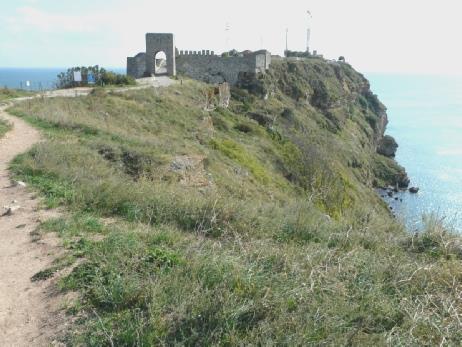
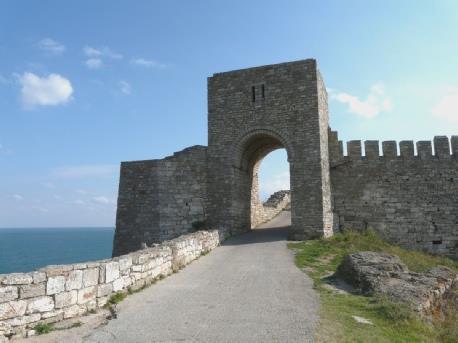
Cape Kaliakra
Adrian had spied a water tap, so filled the tank before we drove off, through Balgarevo, where soon afterwards, at 5 o'clock we found a place to stop for the night - underneath a wind turbine!

The coast at Cape Kaliakra
Sunday 5th October Different aspects of the Bulgarian Black Sea Coast 72 miles
It was a fine morning. While cooking our fried breakfast, the smoke alarm went off, and wouldn’t stop.
We drove through Kavarna, which was still sleepy on this Sunday morning. Trees usually hid the ugly apartment blocks.
We took a small road by the sea before Balchik, below the tall white cliffs. There were a lot of apartment blocks, but we followed a tiny road right down to the shore. As we stopped beside the rough stony beach, we saw a small black squirrel. There were several little fishing boats and jetties, and a pipe with warm water smelling like spring water. It was sunny and beautiful. We could see a cormorant on the sea and in the distance we could see the town of Varna. There were one or two people by shacks, with signs saying 'fish'. Although we had some fish for tonight, we thought that we ought to buy some. The man we asked was just leaving, but took us to his 'friend'. In a mixture of German, English and signs, we bought 3 fish, declining the large piece of fish he showed us, possibly tuna. We sat on an old tyre on the beach to have our tea/coffee, leaving at 11.15. It had been a good stop.
We drove on into the pleasant, low-key town of Balchik, passing its port. We parked by the sea and walked along the promenade, walking past a lot of eating places. We stopped by the last one, where the chap did a good job of nicely enticing us to eat there. It was still early, but we both enjoyed an excellent fish soup, sitting in the sheltered eating area beside the beach.
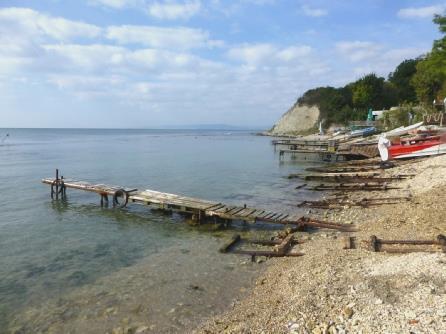
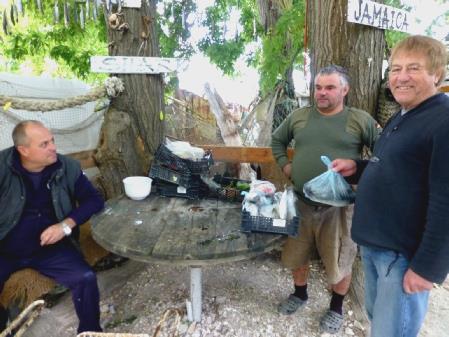
A genuine bit of Bulgarian Black Sea coast
We had an internet connection here, and were able to receive emails on our phone. We received a lot of nice emails in response to our last website email, the most exciting being from Alice, who told us that she and Jason had had a little girl in August. She had attached photos of them and Skye & Aspen. We were thrilled.
We walked back to the van, and drove on a short way, hoping to see the Royal Palace, built by Queen Marie, the English wife of King Ferdinand, who we had come across at Bran and at Curtea. Balchik was part of Romania then.
We had trouble, as usual, in finding the way in, and had to park in a paying car park before wandering past all the stalls as ever. We then came to the entrance, and the two separate pay kiosks – one for the palace, and one for the Botanic Gardens, which you had to walk through. Although initially annoyed at this, we really enjoyed the gardens, which were of a very high standard. The large greenhouse full of cacti and succulents was particularly impressive. Everything was labelled in both Bulgarian & English. More cacti and succulents grew outside, as well as colourful annuals and roses. It was all beautifully maintained.

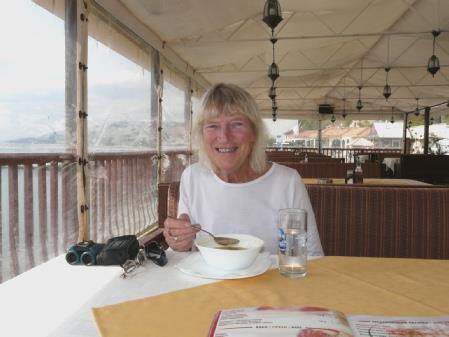
Adrian under a palapa at Balchik
Nice fish soup lunch
The 'palace' was quite small, but pleasant, with some lovely wooden chests. Outside was a pretty waterfall and mill.
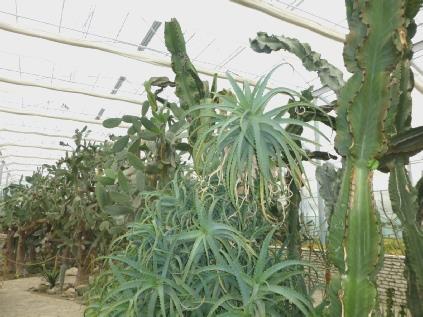

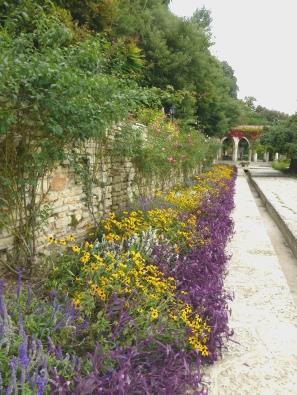
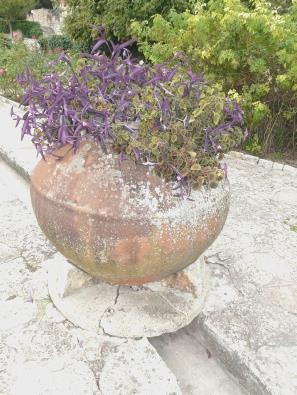
The Botanic Gardens at Balchik
Being Sunday, it was fairly busy, but not overly so. We walked back to the van past the stalls of mostly 'tat' – not all were open.
Driving on towards Varna, we appreciated Balchik even more, as all we saw were vast holiday complexes. We did see our first Bulgarian horse and cart though, and later saw another!
We had hoped to stop for the night before Varna, but this wasn't to be. In fact, it was probably good to drive through on a Sunday afternoon, as it was fairly quiet. We pulled in beside the road at the first opportunity we had to work out our onward journey, and discovered that we were right beside the excavated Roman Baths - the only site in the town which I had wanted to see!

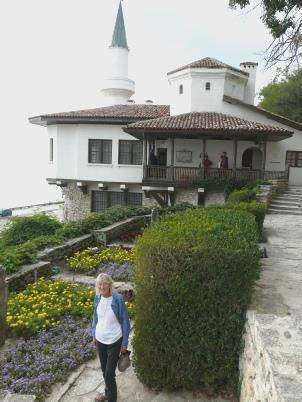
The Royal Palace at Balchik
We crossed an inlet on a vast bridge and then turned off south of Varna, hoping to find somewhere to stop, but couldn't get to the right road. We drove down to a rubbish dump area on rough tracks, but although it wasn't suitable to stay, we could 'fly dump'. We then relaxed with a cup of tea before taking the fast road south - the only option. We turned off and drove through the village Novo Orjahovo - it was good to see 'real' places again - coming right down to the sea at Skorpilovciat at 5.30. There was a derelict wooden cafe and shack beside a sandy beach. The ruins of an old pier showed that there must have been something here once. It made an ideal place for us to stop for the night.

The Roman Baths at Varna
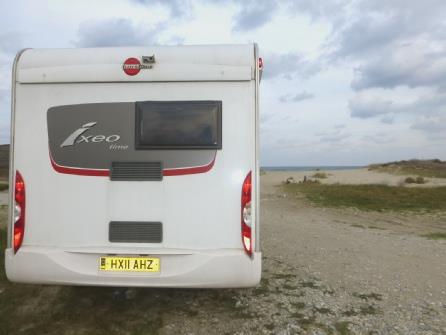
Monday 6th October More contrasts as we continue south 55 miles
It was mostly overcast but the sun did peep through and shine onto the water occasionally. Adrian had great trouble with the alarm light on the van, which hasn't been working properly (and still isn’t!)
We walked along the beach on the very plodgy sand. There were lines of shells, and a few jellyfish.
It was nearly 10 o'clock when we left, reaching the main road at the rather unloved village of Staro Orjahovo. We had stopped by a spring and filled a bottle of water, but it smelled quite strong. We drove south on the main (only) road through rural, undulating country, often forested, with some beautiful autumn yellow. We passed a few villages then reached the sea at Obzor, where there were vast holiday apartment blocks. We drove around the town. Huge piles of large logs were stacked outside many of the houses, sometimes neatly, but often straying out into the road. It was as if everybody was getting ready to shut themselves up for winter!
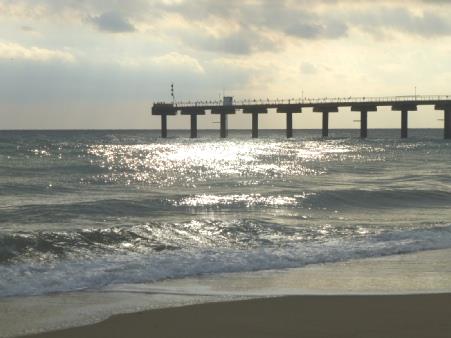
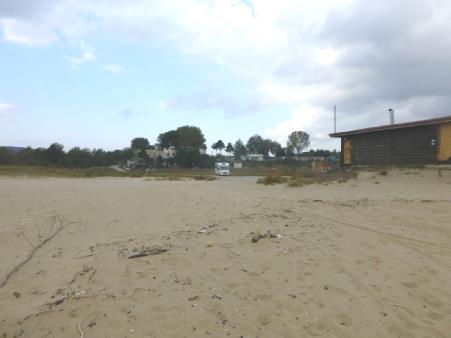
Skorpilovciat
We walked onto the wide sandy beach, which was quite deserted.
As we drove out, we saw lovely blue and white convolvulus beside the road.
We turned off on a dreadfully pot holed road towards Cape Ermine. After bumping along for several miles, the road became a dirt track. The road wasn't wide enough to turn around, so Adrian had to reverse for some way, until, with me standing outside, he could do a 'many point' turn! A short way back there was a turn off to 'Vaya Beach'. When we reached this, there was a house with flowers outside, and a sign saying about the beach - some parts free, some paying. Presumably people did brave this road in the summer to enjoy the nice sandy beach with cliffs to either side, although there was very little parking.


Ready for the big freeze!
We had our lunch here, with just a distant view of the beach, leaving at 1.30.
We bumped our way back to the main road, and continued on our way. There were a lot of large roadside advertising hoardings. Some were empty, but others advertised things such as combined harvesters, tractors and wood stoves!
We made a massively long descent to Slandcev brjag (Sunny Beach), a horrendously huge mass of apartment blocks making one think of Benidorm. We very much needed some shopping, so against our better judgement, went into a 'Penny Market' We did get quite a bit of what we wanted, although fresh stuff is mostly of poor quality. When we came out, a couple of cyclists asked us (in Bulgarian) about the van, and how much it cost!
We drove on a short way to Nesebar, a small island connected by an artificial isthmus. It has many churches (it supposedly once had 80) and has become a tourist trap, apparently unbearable in summer, but very quiet out of season. You have to pay to park here - the first car park charged 6 lev an hour for motorhomes! We moved on to another one, by the harbour office, which had a 24 hour price, (12 lev about £5.00) and it seemed to be OK for us to stay in the van overnight.
We set off on foot, and firstly walked right around the edge of the island. There were rebuilt bits of ancient walls, and partly restored churches all around. It was all quite pleasant.
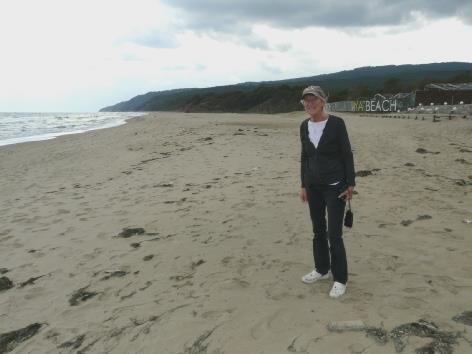
Remote Vaya beach
Only some of the many stalls were open. There were eating places galore, many with wonderful sea views. We looked in at some, but none had prices by the menus. We tried to find out, scouring one or two menus. On reading Lonely Planet, it confirmed what we had suspected. It said that prices were geared to the tourists, and were twice as much as in other places. We returned to the van, past the harbour with its collection of pleasant little fishing boats and I cooked a tuna/pasta dish!

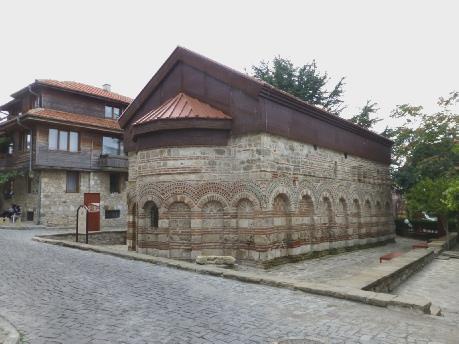
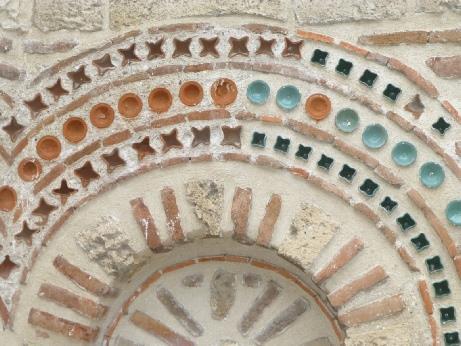
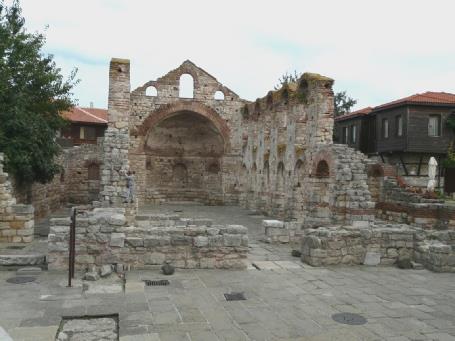
Some of the ancient churches of Nesebar

Top Bulgarian, bottom English - would you recognise it?

Fishing boats at Nesebar
Tuesday 7th October 'Real' places, and Bulgaria's RSPB 48 miles
The morning was mild, grey and damp. We were right outside the shipping office. Several people, mostly women, gathered noisily by the door of the building. We couldn’t work out what it was all about. Some seemed to be holding a large number, and a pad of notes. We imagined that perhaps it was a strike, but the people seemed to be happy, not angry.
When a coach pulled in beside us, we wondered if they were couriers, waiting for a cruise ship to come in.
Adrian became quite anxious that we might get hemmed in by more coaches, so we hurriedly prepared to leave. It was now 9.00 am. As we drove out, we could see a cruise liner just offshore, so we think that we were right!
We drove back a short way to a post office we had passed yesterday, hoping to get stamps for the postcards I had bought some time ago. However, parking was too difficult – this is a tourist area – so we had to give up.
We drove on, passing non-stop apartment blocks. When we saw a Lidl, we went in, but although the veg was better than Penny market, I still couldn't get any decaf coffee. We did see camomile tea, clearly labelled. Yesterday we had spent a long time in Penny market working out what we hoped was camomile!
We now went on a short straight stretch of road, where motorists overtook quite crazily. We soon came to Pomorie, another peninsula sticking out into the sea, but not the tourist trap of Nesebar. Here, the island was full of 'living' apartments, and was a Bulgarian holiday place and not one for foreign tourists. We found a road along by the sea, and had our drink sitting on a wall above it. We were by a simple promenade and it was all so quiet.
We drove on a bit along the island and stopped by the sea again, parking between a Lada and a Trabant! In front of us was a little harbour with a line of fishing boats pulled up on the shore. In a little makeshift hut, fishermen were selling their fish to locals, mostly women. There was a very real atmosphere as groups of men chatted happily.
We stopped again at the far end of the island and found that we had an internet connection. We had been quite concerned, as we hadn't been able to get one in Bulgaria until now, except for when we had been given a password in a restaurant. Consequently we spent some time reading and replying to emails, so by then it was lunchtime!
Afterwards we walked down to another little harbour, with a lighthouse off shore. There was a sandy beach with shells and once again there were lots of local fishing boats.

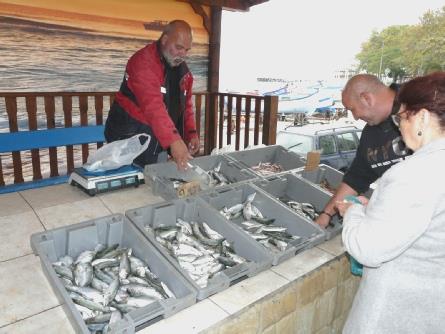
Local fishing, Pomorie
We didn't leave until nearly 2.30. The island seemed to be jam-packed with apartment blocks as we tried to find our way off it again. This proved more than difficult, as the main road was closed, and there were no signs telling you where to go, leading to much confusion for us and for others!
We drove on now towards the large town of Burgas. We weren't interested in the town itself, but there were nearby lakes which were supposed to be good for bird watching. Adrian had to negotiate part of the town, with all its huge tower blocks, before finding the road we wanted. We knew that there was a badly signed BSPB (Bulgarian RSPB) centre off the fast road south. In fact it was off the northbound carriageway, so we had to return until we found what we hoped was the right place. We parked in the small parking area, and then walked along a track. With notices only in letters we couldn't understand, there was no knowing where we were going!
Luckily it was the right place! We came to a building, and were greeted by a young lady who spoke good English, and took us into the centre (the only visitors) We paid our 4 lev each, and she led us up many stairs to the roof, where she pointed out Dalmatian Pelicans in the distance, and also a marsh harrier. She gave us use of strong binoculars each, before pointing out many other birds on the surrounding lakes. (She knew the names in English too!) We then walked along a track, stopping at a small hide, which wasn't actually open, as the man had been working on it, but from the top of the steps we saw many birds, including a kingfisher on our return. Other birds we saw were squacco herons, little egrets, greater cormorants, little grebes and pygmy cormorants. We were delighted to see these, as they were new to us and are an endangered species. It had become beautifully warm now, so we really enjoyed our visit.
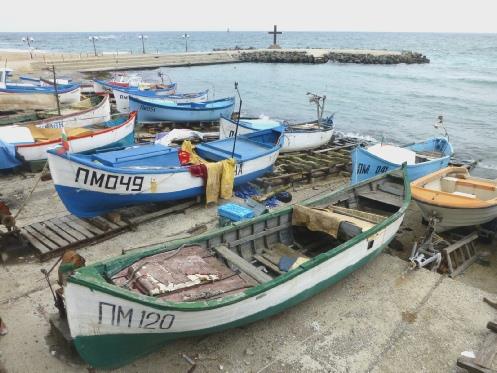
Another fishing harbour, Pomorie
We now had to continue on the carriageway back toward Burgas, so thought that we'd turn off at the end of the road between the lakes to another dyke across two of the lakes. We hadn't expected to come to another area of huge apartment blocks, Meden Rudik, part of outer Burgas.
We managed to find the road across between the lakes, but there were no possibilities of turning off. Once on the other side, we did come to a rough bit of ground, near a village called Tvarditsa, with the sun shining down on the water before it became misty.
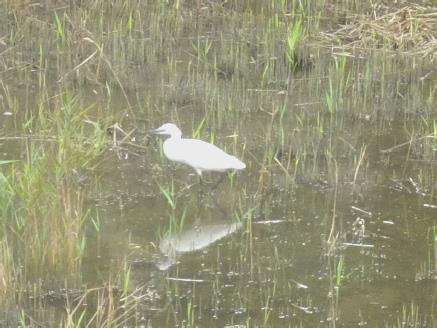
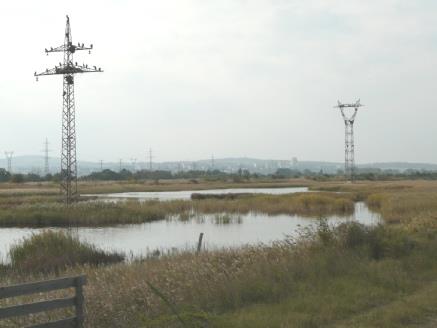
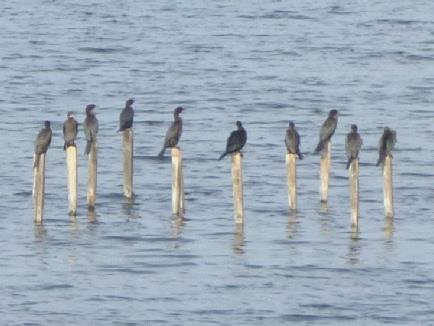
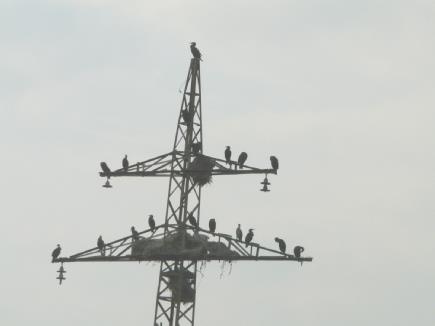
Poda BSPB Reserve
Wednesday 8th October The contrasts continue! 51 miles
When we got nearly back, we passed a post office, so at last I could buy some stamps. The lady spoke no English at all, but I think we made her understand. A man outside had wanted to greet us, but similarly spoke no English.
We came back and I wrote the postcards and Adrian went back to post them.

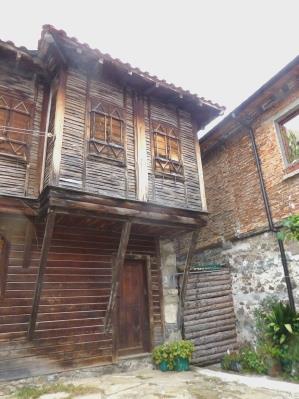


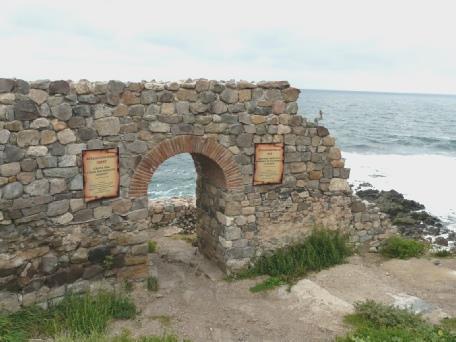
Sozopol
It was at this point that we became aware of an unwanted visitor in the van – a mouse! Yesterday I had seen one of Adrian's licorice allsorts loose, and thought it strange. Now I saw more – and chewed! I had also wondered why there had been a hole in my bag of muesli, and then again when I had put it in another bag. I had also thought I had seen droppings, but had discounted it. On investigating further, I found that it had gone for the rice – organic brown rice at that, none of your cheap stuff! I wasn't happy about it at all, and set about clearing out the food boxes.
We drove on south, coming to what was called 'Green Life Beach'. We walked across a wild sandy beach to the sad sight of stashed up palapas and a forlorn taverna. There was development up behind – another ruined stretch of coast.
A bit further on we passed a vast hotel complex, but then came to the Ropotamo Nature Reserve, although we didn't see any signs. At least this was an unspoilt area. We pulled in, with the sea one side of us and a marshy lagoon on the other. Sea birds flew over on one side, and on the other we saw marsh harriers and Adrian thought an Imperial Eagle. We had lunch here before a quick blow on the wild sandy beach, leaving at 2.20.
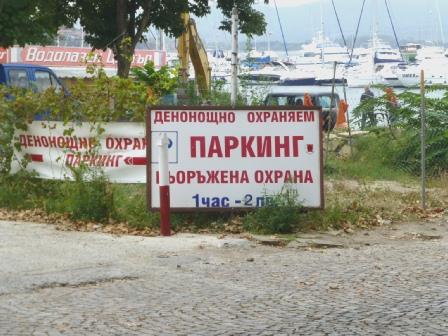
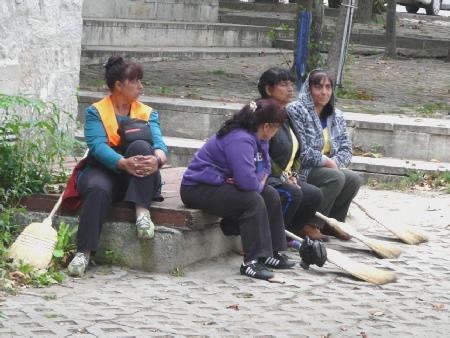
Would you recognise this as Parking?
Street cleaning ladies

Marsh harrier
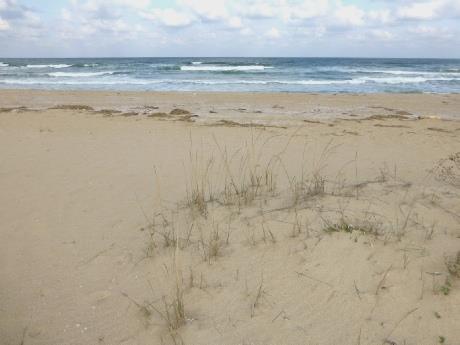
A bit of beach just for us!
Overnighter near Varvara
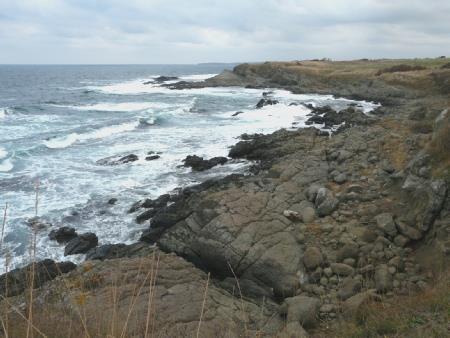
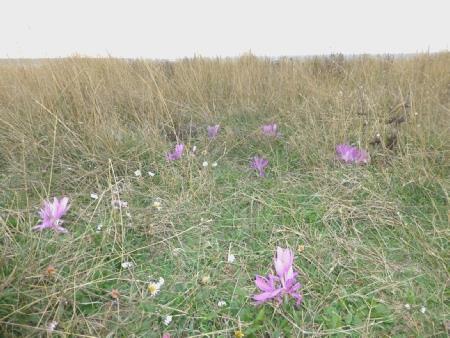
Thursday 9th October To the end of the road, then into the wild 86 miles
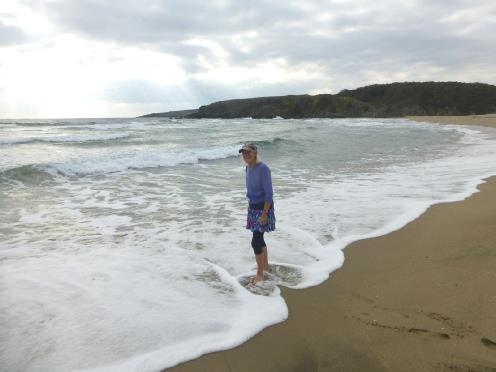
A real paddle in the Black Sea!

‘No photography permitted in neighbour territory’!
Now it was time to head inland, so at Carevo (Tsarevo) we took road 99. We were in the Strandzha Nature Park, which occupies this southeastern corner of Bulgaria. The road was dreadfully badly surfaced. If it had been resurfaced, it was only on one side of the road, so whichever side it was, you had to beware of the rare vehicle coming the other way!

Goodbye to the Black Sea
We were driving through non-stop forest, and although lovely, we rarely got the chance to see views of the countryside. Adrian noticed a water spout beside the road, so we pulled in. The water came from a spring, and tasted wonderful. He set about filling the tank while I walked up to a covered picnic table, and a map of the park (in Bulgarian). Nothing had been maintained, so to get to the table was quite a feat, but it was warm, still and quiet. A tiny blue butterfly flew past. There were blue chicory flowers, and mint - I picked some. A lovely stop!

Nice scenery, shame about the road!
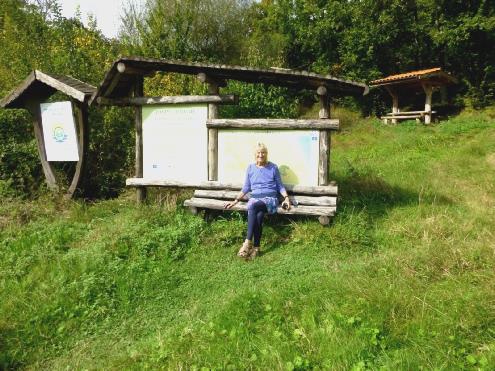
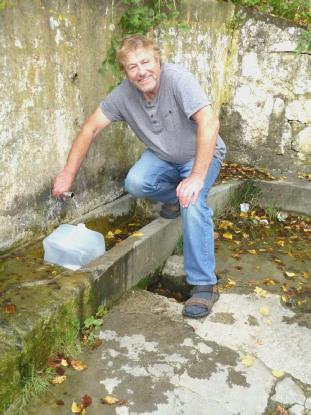
A lovely stop in Strandzha Nature Park

A rare glimpse of the remoteness, Strandzha Nature Park
Friday 10th October One of those days! 126 miles
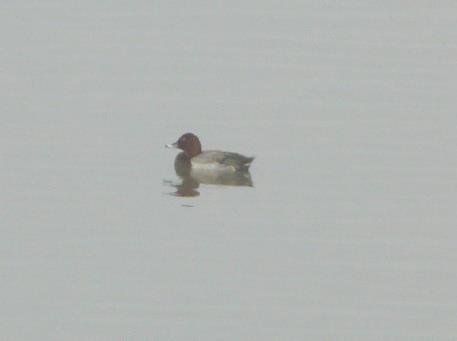
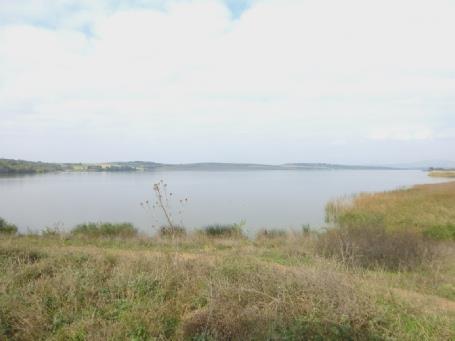
The lake at Burgas and one of the pochard
Adrian set about gutting the fish we had bought from the fisherman the other day which he then cooked on the stove outside.
Later he succeeded in mending the radio.


Autumn colour as Adrian cooks the fish
Saturday 11th October Pot of gold at the end of a good day 107 miles
We drove on, coming to an unexpectedly steep sided forested gorge before Targovista. There was a 'Crazy Horse' style statue on the hillside.

Fishing - the international pastime
Targovista had ugly communist housing blocks. From here we drove cross country, stopping near Popovo where we had a walk beside a reservoir with lots of bullrushes. It was warm and sunny. There were one or two fishermen - one had set up his lines, and was lying fast asleep in the sun!

‘Crazy horse’
Soon after this we came upon a partly restored Roman fort. It cost us 50c(25p) each to view this! (oldies rate). After walking across pebbles, the walkway was on rough, uneven logs, which was rather difficult for me!
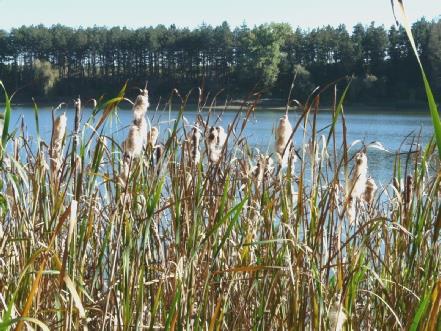
Bullrushes by the lake
From here we continued on variable road surfaces to the campsite at Dragizhero, called Camping Veliko Tarnovo. It was now 5.30.
It was a nicely laid out campsite in a lovely setting. There were just a few vans here. The swimming pool was empty, and the cafe closed for the season. We were greeted by the cheerful English owner called Nicky. It all seemed so pleasant. Nicky told us that it had rained really heavily lately, but was forecast to be dry for the next few days.
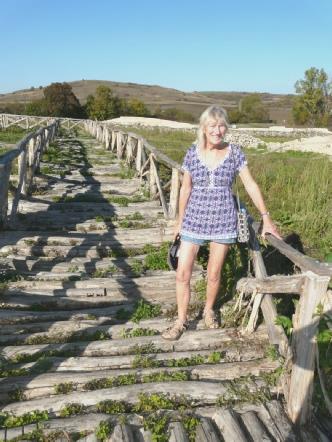

An unexpected Roman fort
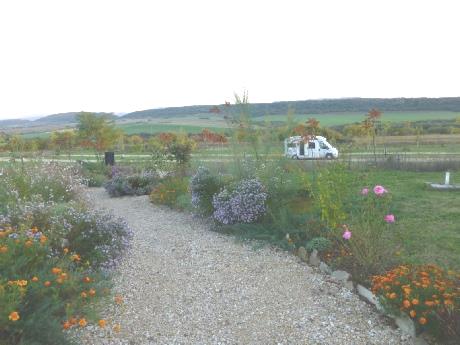
Lovely campsite at Dragizhero
Sunday 12th October Veliko Tarnarvo 17 miles
We enjoyed a really good meal – Adrian had squid and I had broccoli risotto, all beautifully presented. The dark beer set it off well. We shared a desert of 'Turkish Cream', rather like a solid brulee with thick caramel, and quite delicious, all for £15.
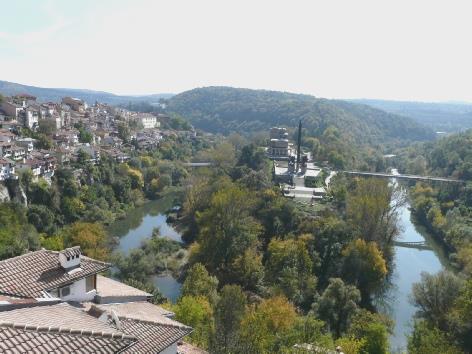
View from the balcony of Shtastlivetsa Restaurant
Well mellowed, we wandered along the narrow cobbled streets, passing the area of craft shops, where I bought a pretty bracelet, and we spoke to a Canadian couple from Toronto. In fact we heard a lot of English being spoken. Nicky had told us of a large British population in Bulgaria.


A really nice meal!
We made our way to THE 'thing' to see here - Tsarevets fortress. This enormous fortification, set on the hill in one of the meanders, has apparently the remains of 400 houses, 18 churches and several monasteries. It was quite busy on this Sunday afternoon. We didn't get very far in walking around it, as all the roads are steep, and made of uneven cobbles. We'd walked quite a way already! We did get an impression of it, and it's location, and had wonderful views back to the town.

One of the cobbled streets of Veliko Tarnarvo
Leaving the walls of the fortress, we started back towards the rest of the town, stopping by impressive St. Bogoroditsa Church, which we peeped inside to see the ornate interior.
Carrying on through the town, we stopped near to our lunchtime restaurant and enjoyed a welcome icecream (sold by weight, as many things are, so we ought to forgive the lady back in Romania who had charged our meal by weight).
We found our way back to the van – glad to be going downhill – passing again the smart area of clothes and shoe shops. It was 4.15, so we made our way back to the campsite at Dragizhero. After dealing with all the washing, I was able to enjoy a few minutes sun before the evening cooled down.
We were able to speak on skype to Tom, Mar & Rita, to Paul, Louisa & Joanna and to Emma, and even to Felix & Ruby, so to all our children and grandchildren this weekend.
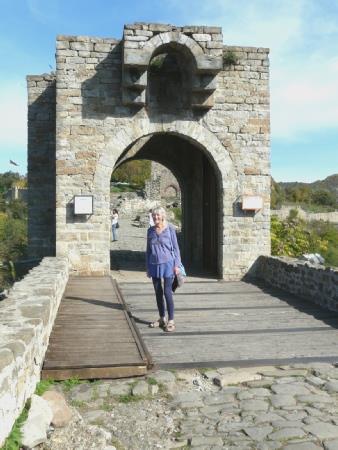
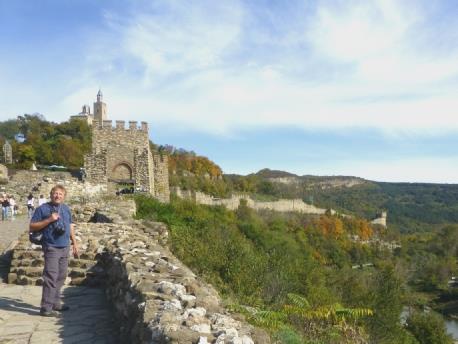

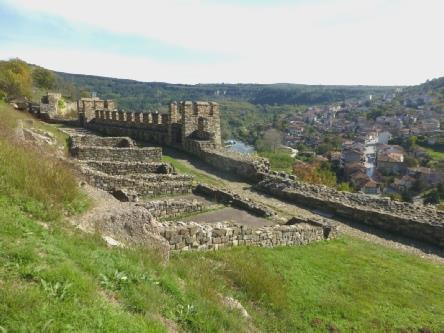

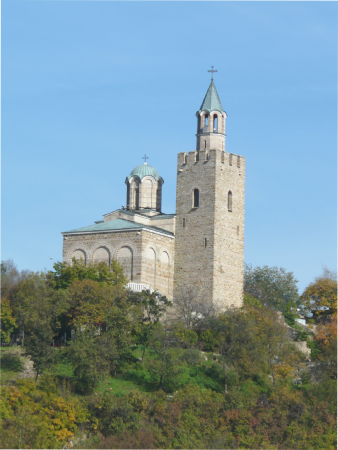
Some glimpses of enormous Tsarevets fortress
Monday 13th October A monastery in the autumn sunshine 48 miles
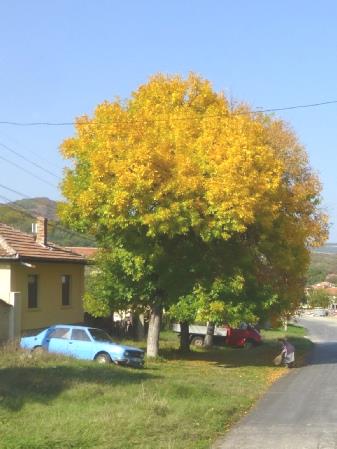
Sweeping up the leaves at Dragizhero
We walked up beside the river towards some caves, but stopped when we came to rough steps going upwards! Walking back, we stopped by the 'adventure playground' – an amazingly unsafe contraption of ropeways strung between trees above the river.
We continued south now, driving through the unexpectedly large town of Gabrovo. All we saw was ugly communist apartment blocks and bumpy roads, but we did pass a large fruit and vegetable market as we drove out.
We turned off onto a pretty road winding up into the hills on the way to Trjavna, a wood carving village which we want to visit. We thought it too late tonight, so when we came to a place to park beside a large concrete war memorial we pulled in. It was 5 o'clock. A sign said that we were on the edge of Stara Planina National Park.


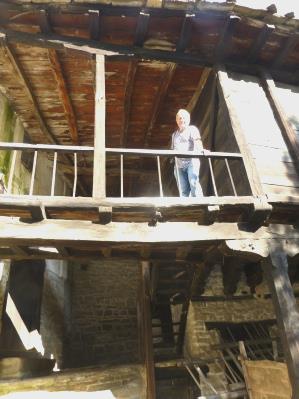


Various views at Drjanovo Monastery


We were just before the village of Nikolaevo. We worked some more on the website.
Tuesday 14th October The Shipka Pass in autumnal glory 57 miles
The sun was peeping through the trees on yet another beautiful day. Although we were at 2,400ft, it hadn't been cold. We watched the large lorry being loaded up with logs opposite. It left just before we did at 8.50, but we soon caught it up on the many hairpin bends as we descended to Tryavna. We found Tryavna to be very spread out, and couldn't find the centre. On circling the town, we met the logging truck coming the other way! (reminded us of a wonderful Column Sands song - ‘Directions’).
We saw a lot of old characters as we drove around, but apart from several fruit and vegetable stalls and shops, we thought the place pretty crummy! The middle of the town was dug up, which made it even more difficult to locate where we were. Lonely Planet had raved about it as being very attractive, with lots of craft shops, but we could see nothing interesting!
In the end we parked and walked over a bridge to one nice wooden house. There were a lot of people about on the street.
Almost back at the van, I noticed a sign to 'Craft Street', so we followed that. Eventually we came to a lot of attractive houses, and obviously the bit we were looking for. Not much was open yet, but at least we had found the right area!

Nice house in Tryavna
Giving it up as only a half success, we wound our way back up all the hairpins, passing last night's spot, and then driving again through the village of Jarlesh, which seemed to go on for ever, as we came down to Garbrovo. The part of the town we drove through didn't inspire us any more than yesterday!
We were now driving on to Etar, a village folk museum. We didn't find anywhere to stop on the way, so at 10.45 we stopped in the car park. Adrian went to find out about parking, with difficulty as nobody spoke English. In the end the lady was satisfied with my Blue Badge, so we didn't have to pay to park.
If Tryavna hadn't worked out, Etar was a great success. It was a superb Folk Museum (4 lev each).
It was set along a cobbled street, with 50 'workshops', most powered by the little stream which ran alongside. There was wood turning and pottery, and even sweetcorn being ground. It was very atmospheric, and the warm sunshine made it so enjoyable. There were other visitors, most notably a large party of primary school children, with their backpacks, just like any other kids. They had been keen to spend their money – many buying little whistles which had been made there!
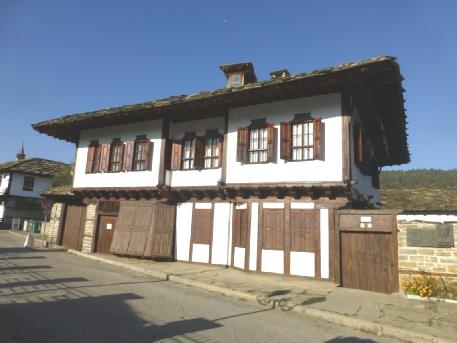
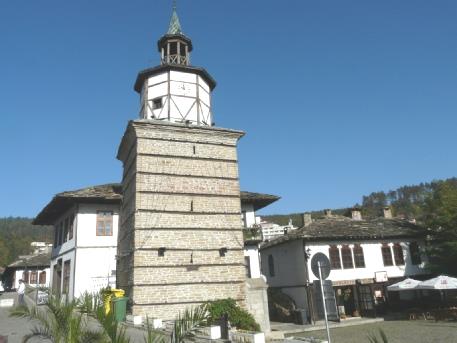
Atmospheric part of Tryavna
Now we headed towards the Shipka Pass (1300m), and if we'd had bad weather on the Transfagaras Pass, we had brilliant weather for this! The clear blue sky set off the autumn colours beautifully. We stopped in a sunny layby to have lunch - just a shame about all the litter again, and of course no picnic tables.
When we reached the summit, it was hot! It was also very quiet. We stopped to take in the views before driving on up to the massive monument to the 7,000 Russian and Bulgarian soldiers who had died in 1877 in the battle against the Turks. We didn't walk the final long steps to the actual monument. There were several monuments on different hill tops – we walked a few steps to a small monument, laughing at the thought that it was like a child's one!

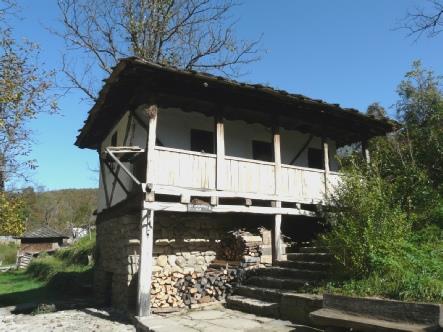



Etar Folk Village
As we zig-zagged down to the village of Shipka, the trees were like an autumn tapestry. We stopped in Shipka to look up what was here, when we spied the amazing sight of the gold domes of the monastery above us. We made our way to this most beautiful creation. It had been built in 1902 to honour the soldiers killed in the Shipka Pass battle. It certainly is glorious, being in pink, with many other colours inlaid, and topped by the sparkling golden onion domes. Inside, every wall was attractively painted with religious paintings. We went down into the crypt, where the Russian soldiers bodies are interred.

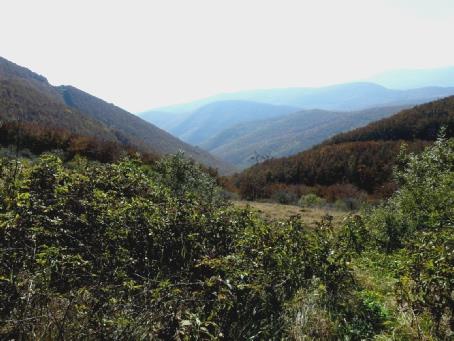
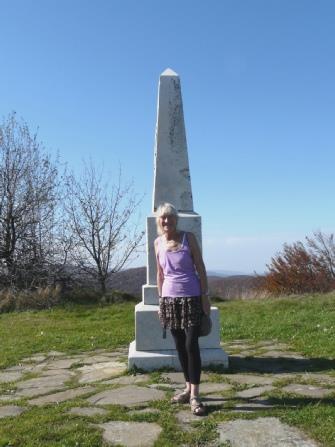

Shipka pass
The soldiers monument and our little one!
Now we wanted somewhere for tonight, so continued south, coming after a bit to Koprinka Dam, where, after following a long and bumpy track, we found a place to stop beside the dam. Looking across the water,we could just see the golden onion domes sparking in the distance! We walked across part of the dam before the sun went behind the trees. We looked at a huge solid statue of somebody - no name! Adrian chatted to a young Bulgarian chap from Varna who had been to Aldershot!



Stunning Shipka monastery
We came back and enjoyed the exquisite hazy blue view across the lake before cooking the last fish from the fisherman at the Black Sea.
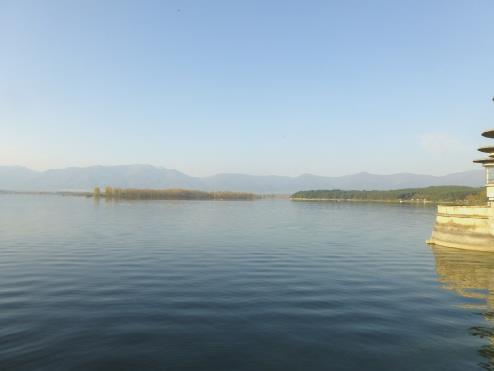
Koprinka dam
Wednesday 15th October Kazanlak and the Valley of Roses 77 miles
We had a few drops of rain, just to scare us, and then another beautiful day. It was misty in the valley, looking quite eerie, with the enormous statue of the man peeping through.
It looked lovely across the lake with the different blues.


Early morning by the Koprinka dam
We walked up in the forested area behind us, high above the reservoir. A really nice start to the day. We could just make out the memorial on the Shipka Pass in the far distance.
We had a discussion on whether to go into Kazanlak, the centre of the rose extract industry, where there is a small museum. Adrian wasn't keen, but when he saw that we didn't have to drive right through the town, agreed to go. There were other things of interest nearby, so we set off at 9.40. We had some trouble in finding the rose museum - no signs - but we finally arrived at the 'Research institute for Roses Aromatic and Medicinal plants.' Lonely Planet hadn't said very much about it, but we found it very interesting. We hurried in, as we saw a large coach party arrive just as we did. We paid our 3 lev each (Lonely Planet had said that it was free, but we don't begrudge just over a pound each!) Afterwards we realised that taking photos cost 5 lev, but nobody asked! In fact only one woman from the coach party came hurriedly into the museum, the rest just bought their rose products from the stall outside! Apart from lots of implements used for producing the rose oil, there were delightful old photographs of the industry.
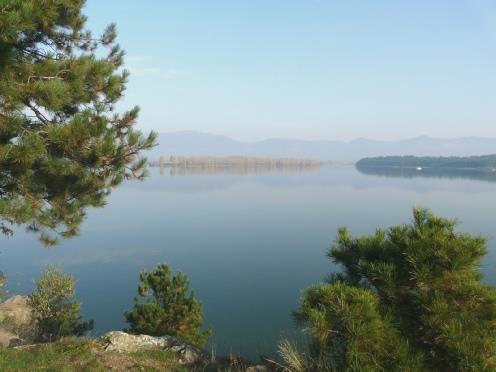
Looking across Koprinka Reservoir
Apparently 60% of the world's rose oil comes from here. The whole valley is known as the Valley of the Roses, but strangely we saw hardly any roses, although the valley is supposed to be filled with them. There were a few plants in the garden outside, but they looked totally neglected, as did the whole area.
The town of Kazanlak has become known for the Thracian tomb dating from the 4th century BC. This was discovered by accident in 1944 during a bomb shelter construction. The actual tomb costs 20 lev, but a nearby reconstruction costs only 3 lev. We opted for that, having climbed up the many steps into the park where it is situated. Photography again cost 5 lev, so we had to be surreptitious! The two attendants were extremely dour. The so called 'museum' consisted of just the tomb and a few descriptive notices. A small group was being given a 'tour' in German, so I tried to listen in!
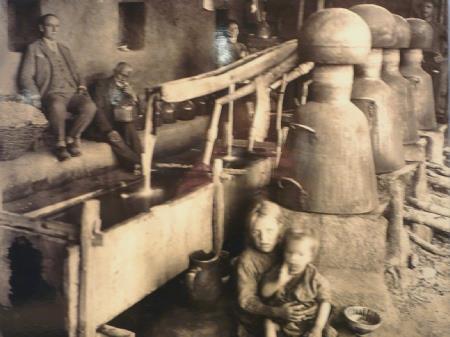
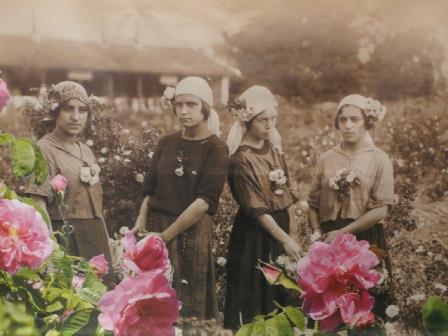
The rose petal stills
Early 20th century rose workers
We walked past more overgrown roses before finding our way to the so-called 'Ethnological Museum' - in fact just two houses, one town, one village, from the early 19th century. The pleasant but rather intense lady described things in English, before we were given our sample of rose jam and rose liquor. She then led us over the rough cobble path (typical of the time, she said) to the houses. Once more, photography cost extra, but we have one or two photos!
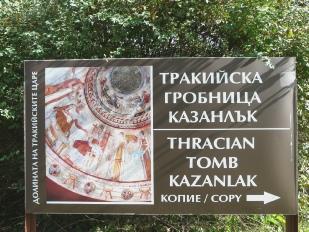


The building housing the original Thracian tomb
Entering the ‘copy’!
It was now midday, and time to leave Kazanlak. We did in fact drive through the town. We needed some bread, so when I thought I spied a bakers, we managed to stop. We were outside a small supermarket, but walked back to a 'bakers', which in fact just sold cheese pastries. We walked a long way along the street, Adrian feeling rather under-dressed in shorts, when many were in winter clothes! We never did find the first bakers I'd seen, and ended up buying a 'plastic' loaf from the little supermarket!
We headed out of town, and along the Valley of Roses, looking for somewhere to stop for lunch. We saw a sign for a water tap (spring), and saw that there were rare picnic tables there. We managed to turn around, but found that the picnic table was made from a car tyre painted bright yellow, far away from a bright yellow bench! We pulled in and decided to eat lunch in the van! This was probably a good move, as people came non-stop to fill their water bottles! I did likewise – the cool water tasted good!
As we drove on, we could see snow on top of the mountains. We drove through the village of Manolovo and stopped to take a photo for Manolo!
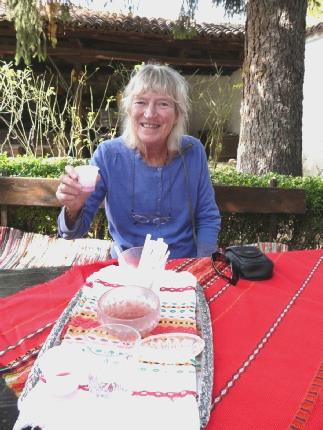

Kazanlak’s ‘Ethnological Museum’
Rosie sampling the rose liquor
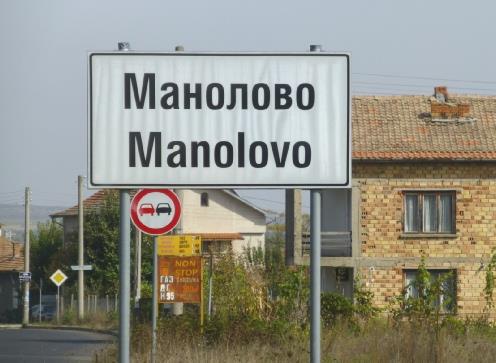
One for Manolo!
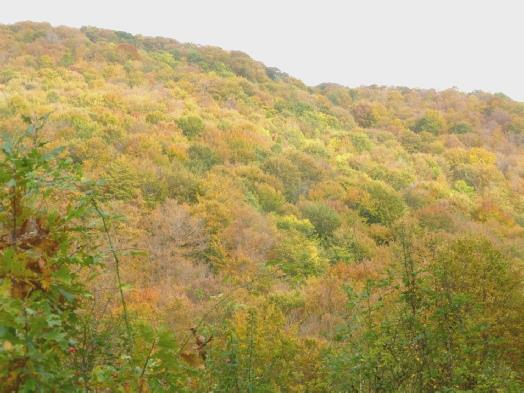

Autumn colours as we walk down to a little bridge
Thursday 16th October Some lovely historic houses 62 miles
There was a bit of rain in the night, but the sun was just peeping over the hill as we had breakfast.
The day was mostly cloudy, but really warm, with a bit more rain in the afternoon.
We left at 9.45, winding through the autumnal forest, following the river, to Koprivshtitsa. This town has several historic houses which you can visit. We found the place to buy a combined ticket - the tourist information wasn't open. It cost 5 lev (about £2) each to visit all the houses. They weren't all open, as we discovered, but we did see some real treasures.
The town itself is very atmospheric with attractive wood and stone houses with lovely roof tiles. We wandered along the warm, quiet, cobbled streets.
The first house we visited was my favourite. It had belonged to Dimcho Debelyanov, a celebrated Bulgarian first world war poet. As we walked around, recordings of his poems were being read out on the loudspeaker in English, followed by emotive music. I felt really moved. There were artefacts and photos, again in English and Bulgarian, so that you got a real feel for the person. He made us think of Rupert Brooke - he had been in Greece and had died in 1916.
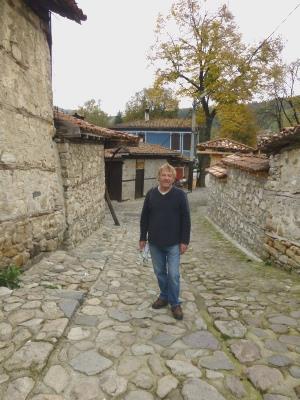
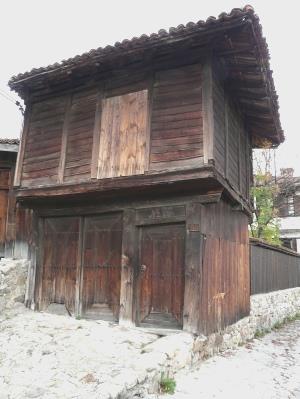
The quiet streets of Koprivshtitsa
We'd arrived there at the same time as a couple with their four daughters, who were being given a guided tour in English, although they were certainly not English – Adrian thought perhaps Israeli. The girls weren’t interested in the chat – they probably didn't understand enough English. The young guide gave the impression of really wanting to talk to us instead! The girls had started singing 'we are family' when they showed their tickets!
The second house we visited was of Todor Kableshkov, a revolutionary activist involved deeply in the 1877 uprising. He made us think of Che Guevara.


Dimcho Debelyanov’s house and his grave, with grieving mother figure
We went on to a house showing the importance of fabrics in the town with attractive displays of the embroidered socks which the town was renowned for, and the fancy felt carpets. We took a few photos, and only afterwards realised that you weren't supposed to!


The home of Todor Kableshkov
One of the houses we walked to wasn't open - cheery ladies were busy painting it! We found that it was now midday, so made our way to another part of the town where we climbed many stone steps to the last house we visited, which was concerned with education, which Koprivshitsa seemed to be a forerunner in.
We’d had a really enjoyable morning in Koprivshitsa, but now 12.30 it was time to leave.
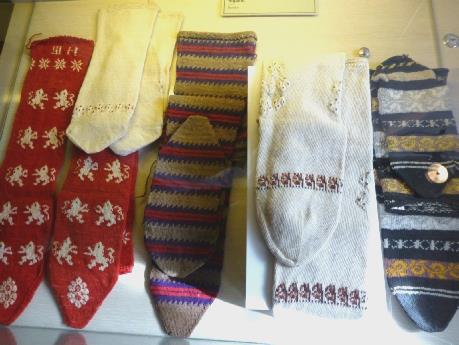
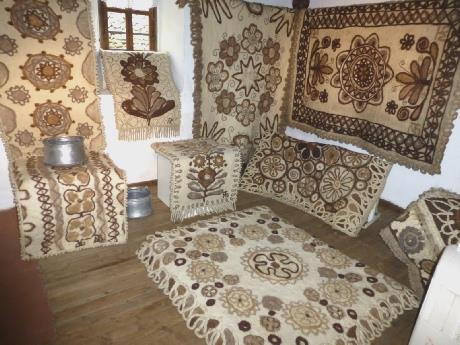
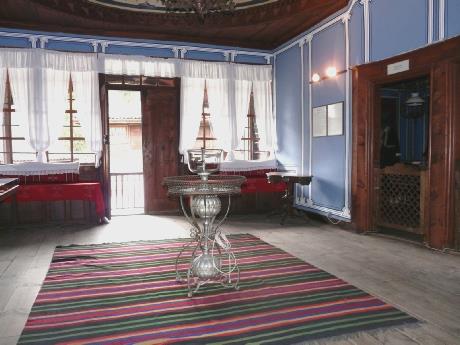
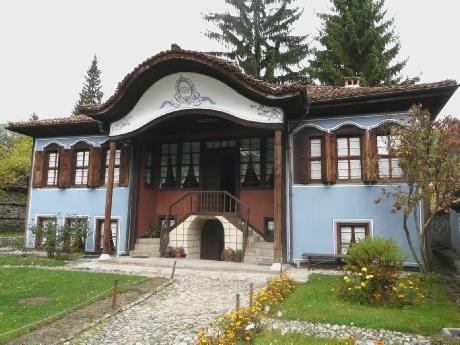
Lyutov’s House


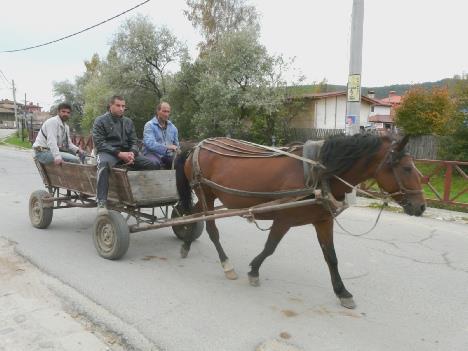
There are old Russian lorries everywhere
There are horses & carts in Bulgaria but not as many as in Romania
Friday 17th October A near perfect day in Plovdiv 0 miles in van
The night was amazingly mild. We had showers in the van without it feeling the slightest bit cold.
We went out to the front to wait for a taxi into Plovdiv. Someone was busy sweeping up leaves – a national past time! We realised that the 'campsite' is actually cared for, with a lot of clearing of trees having been done, but it would look so much better with a coat of paint on the buildings.
We had quite a hairy drive into Plovdiv! The driver had said not to bother with the seat belts! He was playing pleasant English music - very loudly - and nipping in and out of the traffic. We can't complain though - 5 levs (£2) right down to the Old Town. We’d asked to be dropped by the Church of St Konstantin and Elena, which proved a really good move, as it meant that we were driven up the hill of the old town, so mostly just had to descend. A map just shows things as flat, which it certainly wasn't! We peeped inside the orthodox church, where as usual every bit of the walls was covered by paintings.
There was a Tourist Information point almost opposite. We went in, looking for a map of the town. Adrian asked the young male assistant if he had a map. He had large 'tear-off' maps in front of him. He just said 'yes', but didn't offer one! 'Can we have one?' 'Yes' - But Adrian still had to tear it off himself!
Nearby was the 'Ethnographic Museum', which would have been nice to visit, but was vast and would probably have taken the rest of the day.


The tower and entrance to the Church of St Konstantin and Elena
Instead we continued a bit up the street of large cobbles, coming to the Archaeological Ruins of Eumolpias on Nebet Hill, a Thracian settlement dating from 5,000BC! There were views down in all directions over the large town of Plovdiv.
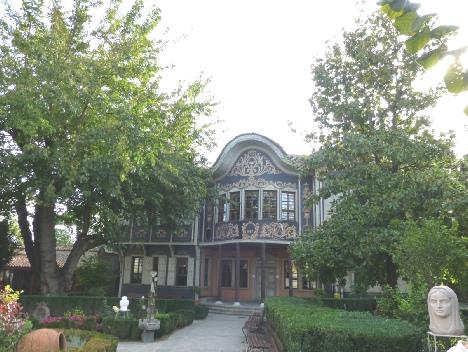
Plovdiv’s 'Ethnographic Museum'
This would have been enough for one town, but there was much more to come!
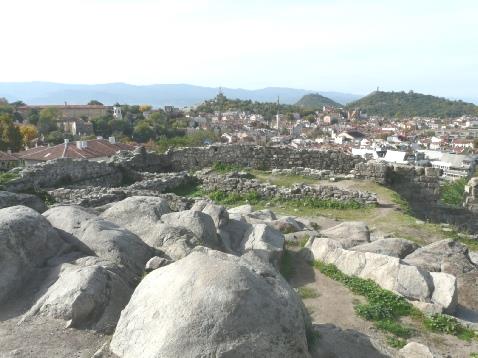
Archaeological Ruins of Eumolpias on Nebet Hill

Two jolly street musicians
We continued wandering the lovely streets, lined with its attractive houses with overhanging upper storeys, often prettily painted. It was beautifully warm, and being out of season, very quiet.
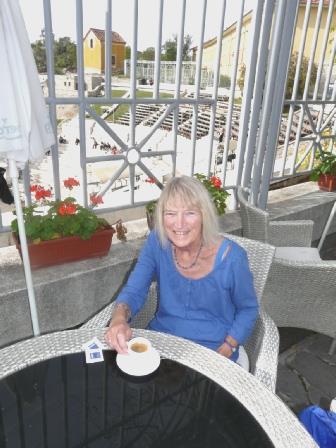

The Roman amphitheatre at Plovdiv
There were the churches of course. We peeped inside St. Dimitar Church, which was much lighter inside than most, being white, with not many paintings. The lady tried to get us to buy a book of photos, as photography wasn't allowed! We looked inside the Assumption Cathedral too, and sat outside on a seat in the enormous courtyard.

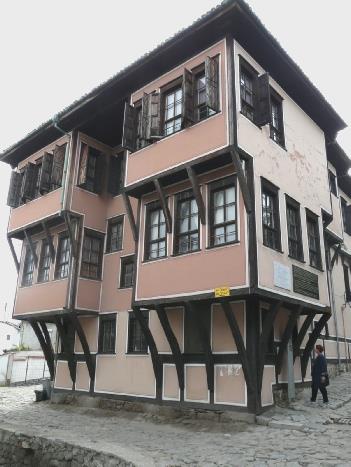
Characteristic houses of Plovdiv’s old town
There were plenty of little tourist shops, and Adrian was pleased to buy a Bulgarian T-shirt with their alphabet (which we've been trying to work out) on it.
We could see the stripy minaret of the mosque, and headed for it, knowing from the map that there was a Roman Stadium nearby. Adrian was just saying 'Well, where is it?', when we spied it below us! It was a bit like finding it below Marble Arch! A plan showed that the actual stadium is enormous, and could apparently have seated 30,000 people! Life was going on above it, and 'Phantom of the Opera' music was being played from loudspeakers, so it was very atmospheric and great fun.

The Assumption cathedral
We turned into a quieter nearby street and sat at an outdoor table to enjoy our lunch. Apart from Adrian’s salad being brought a while before my pasta dish, it was great. The baklava and creme brulee desserts were both wonderful. Adrian was rather annoyed that our dark Czech beers were (relatively) expensive, but it still all only came to £16! We had wondered why there were pictures of tulips and windmills until we worked out that the restaurant was called 'Amsterdam'!


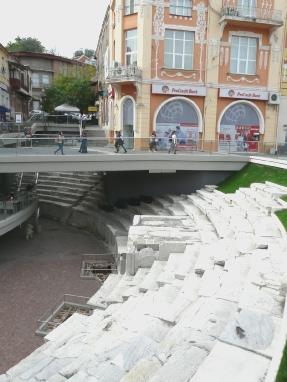
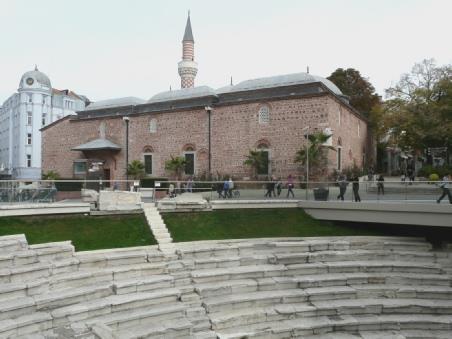
The Roman Stadium beneath main shopping street of Plovdiv with the mosque behind
We now returned to the vibrant shopping street - pedestrianised - with lots of happy people thronging it.
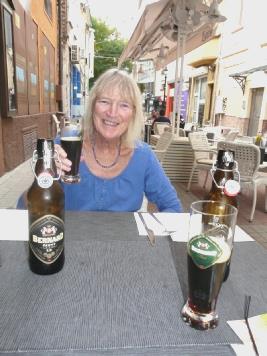

Lunch time beer at Amsterdam Restaurant


This was really busy, with a lot of mums with babies in prams. It made us think of Hyde Park. Everybody seemed to stop to drink from the water fountain - we joined them! Nearby were even more excavations, this time being known as the Roman Forum - it was a bit like being in Rome.
We wandered back into the park, where a group of men were noisily playing chess!
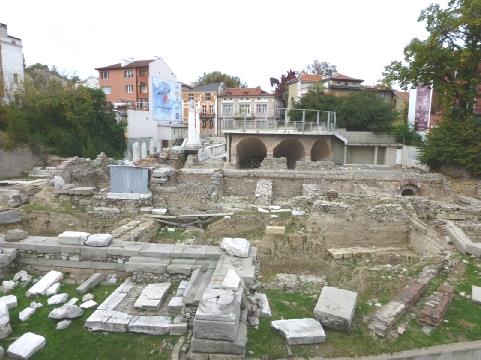
The Roman Odeon
At the far end there were more excavations of the Roman 'Odeon', beside a large green park area.

A serious game of chess!
Notices around said that Plovdiv is a contender for 2019 European Capital of Culture. There was obviously much more to the town than we saw in our short visit.
Getting back to our campsite wasn't quite so simple. We had wandered through Tsar Simeon's Garden, as the park is called, hoping to see the 'Lake of Singing Fountains', but this area was being completely restored, so wasn't there! By now we were both getting weary, particularly as the day had been so warm. We wandered back through the park, coming out at a side entrance, where a young chap getting into his car wanted to chat. We asked him about getting a taxi, and he suggested a nearby road, but it was probably only a guess! We tried hailing one taxi, but he was waiting for a client. We walked along the street, and finally had success. Our ride back to the campsite was much calmer than this morning's! Once back, we walked around this 'interesting' site, before refreshing with a cup of tea, sitting at a dilapidated table outside. It was now 4 o'clock, and had been a really good day.
Afterwards we walked out into the silent, deserted town, quite wonderful now with its antiquity and without any of its tourist traps.
It wasn't so windy this morning. We watched the wildlife around us – a huge flock of starlings, a lot of pigeons, and as always the dogs. The surprise was a man who swam naked in the sea, while his wife looked on, holding his clothes for him! He obviously didn't feel the cold, as he was in no hurry to get dressed!
We finished our second part of the website, and sent the email. We then walked across to the sea. While looking at a small bird that we didn't recognise, and trying to photograph it, a wave came and got our feet wet! The water was surprisingly warm, but Adrian wasn't too happy!
It was gone 11 o'clock when we left. A few minutes later we came to the Bulgarian border. Of course the first thing we noticed was the different alphabet – we wondered how we could get on when we couldn't read any of the words, although most names are written in both letters.
Everything at the border looked very run down and forlorn. We had to get a vignette to drive on the roads here too, but this went OK. Adrian then changed some money – the Bulgarians use levs, not leis like in Romania.
We finished our second part of the website, and sent the email. We then walked across to the sea. While looking at a small bird that we didn't recognise, and trying to photograph it, a wave came and got our feet wet! The water was surprisingly warm, but Adrian wasn't too happy!
It was gone 11 o'clock when we left. A few minutes later we came to the Bulgarian border. Of course the first thing we noticed was the different alphabet – we wondered how we could get on when we couldn't read any of the words, although most names are written in both letters.
Everything at the border looked very run down and forlorn. We had to get a vignette to drive on the roads here too, but this went OK. Adrian then changed some money – the Bulgarians use levs, not leis like in Romania.
We were awoken by a bird or creature scrabbling on the roof in the middle of the night! Then we awoke at 6.30 to hear light rain. It didn't come to anything, but Adrian thought that the van would be coated in thick mud if we didn't move. Hence we drove back towards the road, and settled down for a few more minutes.
We left at 8.45 and soon came to the village of Tvarditsa, where we could put our rubbish in the communal bin. A flock of small birds flew over.
We drove towards Burgas, then south on the main and very badly surfaced road.
We came to Sozopol, the oldest settlement on the Bulgarian Black Sea coast. It has become quite a tourist resort, but was a delightful surprise today, with no visitors.
We parked near a modern marina, so different from the little fishing harbours we have been seeing. The new town was all modern apartment blocks, but the old town was lovely. We walked around the little narrow cobbled streets, making us think of Robin Hoods Bay. There were some excavated ruins, some bits of old wall, and a few ancient churches. Many of the houses were 'Black Sea' style – stone below, with wooden balconied tops. It was really quiet at this time of day/year, with just a few locals about. There were flowers by some of the houses – we were intrigued to see lemon yellow crocuses.
We left at 8.45 and soon came to the village of Tvarditsa, where we could put our rubbish in the communal bin. A flock of small birds flew over.
We drove towards Burgas, then south on the main and very badly surfaced road.
We came to Sozopol, the oldest settlement on the Bulgarian Black Sea coast. It has become quite a tourist resort, but was a delightful surprise today, with no visitors.
We parked near a modern marina, so different from the little fishing harbours we have been seeing. The new town was all modern apartment blocks, but the old town was lovely. We walked around the little narrow cobbled streets, making us think of Robin Hoods Bay. There were some excavated ruins, some bits of old wall, and a few ancient churches. Many of the houses were 'Black Sea' style – stone below, with wooden balconied tops. It was really quiet at this time of day/year, with just a few locals about. There were flowers by some of the houses – we were intrigued to see lemon yellow crocuses.
We soon came to the Ropotamo River, where in summer, the thing to do is to have a trip on a river boat. Four of these were parked up on the shore, but no activity today!
We'd, as always, found it difficult to know where to go or park. We did find our way beneath huge trees to the deserted river, but you couldn't get to anywhere else. There was a loo, so Adrian was able to 'dump'. We tried the other side of the road, but any tracks were pretty inaccessible. We did follow a decrepit boardwalk down to the river, where there were just one or two fishermen. We'd heard the plop of little frogs jumping into the clear water.
It was 3.30 when we drove off, passing the tourist town of Primorsko, stopping just afterwards and walking on a boardwalk to a sandy beach with shells – ours were the only footprints. The sun had come out now. Once again, there was a closed up shack cafe.
We'd, as always, found it difficult to know where to go or park. We did find our way beneath huge trees to the deserted river, but you couldn't get to anywhere else. There was a loo, so Adrian was able to 'dump'. We tried the other side of the road, but any tracks were pretty inaccessible. We did follow a decrepit boardwalk down to the river, where there were just one or two fishermen. We'd heard the plop of little frogs jumping into the clear water.
It was 3.30 when we drove off, passing the tourist town of Primorsko, stopping just afterwards and walking on a boardwalk to a sandy beach with shells – ours were the only footprints. The sun had come out now. Once again, there was a closed up shack cafe.
We continued south, but any charm that we had felt was lost, as we disappointedly came across one development after another, many were left half finished.
We were hoping to find a campsite open, as we needed electricity for the computers, after several days of low mileage to charge the batteries. Adrian had note of three. We went in search of one in particular, finding the actual location, and driving around the desolate site – all water and electricity turned off. We gave it up as a bad job, but the one nice thing was that we'd seen a green woodpecker as we drove in.
It was all very frustrating, as we had passed places we could have stopped at earlier. All we'd been doing was driving through towns with dreadful topes, speedhumps, holes and bumps. All our concentration was needed, and even then it felt like being on the dodgems! When we stopped, we found that our shower had fallen down and the fixing was broken.
It was 5.30 when we saw a rough track near the sea just before Varvara. We pulled onto it and walked along to the cliff edge. Here we saw a group of large autumn crocuses!
We were hoping to find a campsite open, as we needed electricity for the computers, after several days of low mileage to charge the batteries. Adrian had note of three. We went in search of one in particular, finding the actual location, and driving around the desolate site – all water and electricity turned off. We gave it up as a bad job, but the one nice thing was that we'd seen a green woodpecker as we drove in.
It was all very frustrating, as we had passed places we could have stopped at earlier. All we'd been doing was driving through towns with dreadful topes, speedhumps, holes and bumps. All our concentration was needed, and even then it felt like being on the dodgems! When we stopped, we found that our shower had fallen down and the fixing was broken.
It was 5.30 when we saw a rough track near the sea just before Varvara. We pulled onto it and walked along to the cliff edge. Here we saw a group of large autumn crocuses!
We woke to hear the mouse at 6.30 – this time it was my unopened packet of flying saucers! More clearing out to be done!
We left our last night beside the Black Sea at 9.20. We soon drove through the pleasant village of Varvara, on this unspoilt bit of coast.
Not long afterwards we came to Sinemorec, a 'real' Bulgarian town, and the furthest one south on this coast. We were eyed with interest by the swarthy people. The street was being swept with besom brooms. We saw several horses and carts. The developers had moved in a bit, but we found our way down to a lovely cove where the few beach things were closed up for winter, including 3 pedalo boats. The beach shelved quite steeply, but I had a short paddle in the warmish water. Everything was silent and still - this must rate as our favourite Bulgarian Black Sea beach.
We left our last night beside the Black Sea at 9.20. We soon drove through the pleasant village of Varvara, on this unspoilt bit of coast.
Not long afterwards we came to Sinemorec, a 'real' Bulgarian town, and the furthest one south on this coast. We were eyed with interest by the swarthy people. The street was being swept with besom brooms. We saw several horses and carts. The developers had moved in a bit, but we found our way down to a lovely cove where the few beach things were closed up for winter, including 3 pedalo boats. The beach shelved quite steeply, but I had a short paddle in the warmish water. Everything was silent and still - this must rate as our favourite Bulgarian Black Sea beach.
We drove back over the speed humps, and came to a hardware store! The shelves were crammed with various things. I picked up a nailbrush, as I thought that we ought to buy something. What we had really come for was a mousetrap. With sign language, we tried to impart this. The man only had a rat trap, or a 'mouse mat'! (Yes, a real one, not for a computer) We bought one, and will have to try it out.
We continued on a narrow but well surfaced road which goes as far as the Turkish border at Rezovo (but no further). I actually drove for a few hundred yards, just before we came to a sign which said 'No photography permitted in neighbour territory'. As we drove on through the forest, we passed 2 horses and one large log truck.
At Rezovo we parked and walked up some rough steps, looking down to a river with a few boats moored at the side. A cheery bare chested man came back to his car to get his shirt. He greeted us, and pointed out that it was Turkey across the water. We were sorry not to be able to photograph this atmospheric place, but thought it prudent not to after the 'no photograph' signs.
As we drove back through the small village, we noticed again the signs in English 'Welcome; Hotel Green Bar; Fly High; Coffee Club'. There was a small children's playground, with the 'shell' of a car as a play house, as we have seen before.
We drove back through the forest, stopping in a clearing, having driven passed the 'no photograph' sign, and relaxed with a drink. A couple had been collecting something – looked like tiny crab apples - opposite. We saw one or two vehicles now – up until then there had been virtually none.
We continued on a narrow but well surfaced road which goes as far as the Turkish border at Rezovo (but no further). I actually drove for a few hundred yards, just before we came to a sign which said 'No photography permitted in neighbour territory'. As we drove on through the forest, we passed 2 horses and one large log truck.
At Rezovo we parked and walked up some rough steps, looking down to a river with a few boats moored at the side. A cheery bare chested man came back to his car to get his shirt. He greeted us, and pointed out that it was Turkey across the water. We were sorry not to be able to photograph this atmospheric place, but thought it prudent not to after the 'no photograph' signs.
As we drove back through the small village, we noticed again the signs in English 'Welcome; Hotel Green Bar; Fly High; Coffee Club'. There was a small children's playground, with the 'shell' of a car as a play house, as we have seen before.
We drove back through the forest, stopping in a clearing, having driven passed the 'no photograph' sign, and relaxed with a drink. A couple had been collecting something – looked like tiny crab apples - opposite. We saw one or two vehicles now – up until then there had been virtually none.
As we crossed the Veleka River, we passed a police car, and assumed that it was a border patrol.
At the seaside village of Ahtopol we went into a tiny supermarket, which had things crammed on the shelves. We were able to get most of what we needed, including Nescafe Gold decaf (which I wouldn’t buy at home, as I like to get Fairtrade. The other day Adrian had been forced to buy Schweppes tonic, against his bettter judgement!). The fresh produce was of very poor quality again. The brown loaf we bought was pappy, and what I thought was cream cheese turned out to be cheese spread. We couldn't find any replacement rice!
We drove back to a beach near to where we had stopped last night and enjoyed our lunch. Afterwards we walked down onto the pebbly/shingly cove – our last time by the Black Sea. There was just one little newly built wood/thatch shack on the beach.
At the seaside village of Ahtopol we went into a tiny supermarket, which had things crammed on the shelves. We were able to get most of what we needed, including Nescafe Gold decaf (which I wouldn’t buy at home, as I like to get Fairtrade. The other day Adrian had been forced to buy Schweppes tonic, against his bettter judgement!). The fresh produce was of very poor quality again. The brown loaf we bought was pappy, and what I thought was cream cheese turned out to be cheese spread. We couldn't find any replacement rice!
We drove back to a beach near to where we had stopped last night and enjoyed our lunch. Afterwards we walked down onto the pebbly/shingly cove – our last time by the Black Sea. There was just one little newly built wood/thatch shack on the beach.
Just after this we were stopped by border police (we're still in Bulgaria). The two men looked quizzically at our van and asked to see our passports, then said OK. It brought to mind similar times in Mexico when we were often stopped a long way from the border.
After some way, we were joined by another road, and our road became wider and smoother, until we reached Gramaticovo, when it deteriorated again.
Although there were supposed to be walks in the park, we didn't know where they were, and stopping places were practically non-existent.
At 3.45 we found a clearing to stop in, but we had no views of the wilderness hills. We took our cup of tea out into the sunshine, amongst the large leaved oak trees. I found a fallen tree to sit on. Across the road was a badly translated sign saying 'Thracian Rock Sanctuary', but we didn't know where.
After some way, we were joined by another road, and our road became wider and smoother, until we reached Gramaticovo, when it deteriorated again.
Although there were supposed to be walks in the park, we didn't know where they were, and stopping places were practically non-existent.
At 3.45 we found a clearing to stop in, but we had no views of the wilderness hills. We took our cup of tea out into the sunshine, amongst the large leaved oak trees. I found a fallen tree to sit on. Across the road was a badly translated sign saying 'Thracian Rock Sanctuary', but we didn't know where.

As we neared the town of Malko Tavarno, we came to a sign saying 'bumps 3,000 m'! The road was better than we'd been on all afternoon!
At 4.30 we reached Malko Tavarno , a small town of simple houses, where a lot of people were busy on the street. A little boy an a bicycle waved to us.
We now drove north on the smoothly surfaced main road. Half an hour later, on the outskirts of Zvezdec, where we intend turning off, we pulled in for the night beside a defunct petrol station. It felt really rural, with a flock of sheep on the hill in front, and two brown horses, one tethered. Later a pig walked by!
At 4.30 we reached Malko Tavarno , a small town of simple houses, where a lot of people were busy on the street. A little boy an a bicycle waved to us.
We now drove north on the smoothly surfaced main road. Half an hour later, on the outskirts of Zvezdec, where we intend turning off, we pulled in for the night beside a defunct petrol station. It felt really rural, with a flock of sheep on the hill in front, and two brown horses, one tethered. Later a pig walked by!
Well, the mouse mat did work! It did mean Adrian getting up in the middle of the night to deal with it. We hope that it's the only one!
Consequently we were a bit late in getting up. There were no animals on the common land in front of us this morning.
We were about to leave at 9.30, when we found that the radio plug for the ipod (that we play all our music on) wasn't working, so Adrian had to spend some time working out a way to make it play.
We drove through the village of Zvezdec, where people were busy with their besom brooms, sweeping the street in front of their house. There was misty autumn colour in the hills.
We decided not to turn off here, as the sat-nav showed the road as not going through.
We soon came to the turn off we had then decided to take, and were stopped once again by the border police. They pleasantly scrutinised our passports, before telling us that the road didn't go - 'kaput' he said. We could see that there was no surface on the road.
Now we had to completely rethink what we were doing, as we would have to drive back up to Burgas. We had intended exploring a bit of the south, but now wondered if it would be better to go north first.
It was a good road towards Burgas. We stopped by one of the lakes and discussed what we would do. There were a lot of pochard on the water.
Consequently we were a bit late in getting up. There were no animals on the common land in front of us this morning.
We were about to leave at 9.30, when we found that the radio plug for the ipod (that we play all our music on) wasn't working, so Adrian had to spend some time working out a way to make it play.
We drove through the village of Zvezdec, where people were busy with their besom brooms, sweeping the street in front of their house. There was misty autumn colour in the hills.
We decided not to turn off here, as the sat-nav showed the road as not going through.
We soon came to the turn off we had then decided to take, and were stopped once again by the border police. They pleasantly scrutinised our passports, before telling us that the road didn't go - 'kaput' he said. We could see that there was no surface on the road.
Now we had to completely rethink what we were doing, as we would have to drive back up to Burgas. We had intended exploring a bit of the south, but now wondered if it would be better to go north first.
It was a good road towards Burgas. We stopped by one of the lakes and discussed what we would do. There were a lot of pochard on the water.
We set off on our new route. Just as we came to a good stretch of road, we realised that we should have turned off. We retraced our steps and took the smaller road, which had a terrible surface which became worse and worse! We drove through the village of Prisad, pretty with flowers outside houses, and a little grassy children's playground. There were unnecessary speed humps, as the road deteriorated and became absolutely atrocious., with large water filled holes filling the whole road. It looked pretty through the trees, but all concentration was needed to drive. After several miles, Adrian doubted whether we would get through at all, and made the decision to turn round. This was the only road through, so we had to drive right back to Burgas, through the village of Dimcevo, which we had driven through much earlier, to Malinka, where we had turned off after our first diversion. Here we saw a bare chested man unloading logs, and another man dressed in a large black fur coat!
Adrian had decided now to get on the motorway past Burgas, passing the bird reserve we had been to the other day! At Balgarovo we turned off to have lunch, stopping opposite a field of unkempt vines. Little frogs kept plopping into the yucky dyke beside us. It was very hot and sunny, so frustrating not to be outside.
Before leaving, Adrian managed (after several days) to get our emails on the phone. These included one from Simon, saying that Laure had finally got her dispensation approved, and would be going to Zambia for most of November. He asked us if we could go home via Geneva to look after Manolo and Millie for one of the weeks. This posed many problems for us, so gave us something else to think about.
We left here at 2.30 and returned to the motorway as far as Karnobal, where the sat-nav and one map showed it as ending. In fact it is now completed, but we decided to follow the main road to the hills. It was at this point that Adrian discovered that he had a tick bite on his leg, so had to deal with that!
We now drove past extensive fields of vines as we wound up into the hills. We came to Avramoski Pass (440m) and stopped just afterwards, but sadly with much litter and no views. It was very hot and sunny, and we would have loved to have enjoyed being outside. We were in the Stara Planina Hills, which run the whole length of Bulgaria.
At about 5 o'clock we found a sunny space to pull in for the night, again very litter strewn, and with the constant sound of barking dogs. There was a bit of autumn colour around.
Adrian had decided now to get on the motorway past Burgas, passing the bird reserve we had been to the other day! At Balgarovo we turned off to have lunch, stopping opposite a field of unkempt vines. Little frogs kept plopping into the yucky dyke beside us. It was very hot and sunny, so frustrating not to be outside.
Before leaving, Adrian managed (after several days) to get our emails on the phone. These included one from Simon, saying that Laure had finally got her dispensation approved, and would be going to Zambia for most of November. He asked us if we could go home via Geneva to look after Manolo and Millie for one of the weeks. This posed many problems for us, so gave us something else to think about.
We left here at 2.30 and returned to the motorway as far as Karnobal, where the sat-nav and one map showed it as ending. In fact it is now completed, but we decided to follow the main road to the hills. It was at this point that Adrian discovered that he had a tick bite on his leg, so had to deal with that!
We now drove past extensive fields of vines as we wound up into the hills. We came to Avramoski Pass (440m) and stopped just afterwards, but sadly with much litter and no views. It was very hot and sunny, and we would have loved to have enjoyed being outside. We were in the Stara Planina Hills, which run the whole length of Bulgaria.
At about 5 o'clock we found a sunny space to pull in for the night, again very litter strewn, and with the constant sound of barking dogs. There was a bit of autumn colour around.
Although it had become cool after the sun had gone, it was a mild night. The morning was cool, as the sun didn't reach us. We both had showers/hairwash and read emails on the phone – one from Emma telling of a disaster day and one from Simon about our possible visit. We sent replies on the phone and left at 10.15.
We very soon came into Kotel, being amused at a sign for Hotel Kotel. The place itself looked really sad – quite a large town of derelict houses and factories. As it was Saturday, there were a lot of people about. Even the horse looked tired, and was yawning! Fungi was lying being dried, in boxes. A man had arrived with his small milk tanker – a lady walked back with a crate full of bottles filled from it.
We soon came to the Kotlenski Pass, 700m. We then descended a bit and stopped amidst the autumn colour by a water spout. Mist filled the valley and it felt cool.
As we drove through Tica we again saw fungi drying. The swarthy coloured people stared at us. People were filling bottles from another water spout and walking a long way. There didn't appear to be mains water as the villagers seemed to be digging a trench to lay the water pipe which was already laid alongside. We saw a lot of people outside a house, with a drum playing – we thought it must be a funeral.
We continued north through the forested hills. As we descended, we stopped to get some propane gas. They didn't take a visa card, so now we needed to get some money. We drove into the town of Omurtag, passing a large green park area. Adrian had looked up banks, but I saw an ATM, so we stopped to get some money. Opposite was a small supermarket where we were able to get a nice loaf of bread and some brown rice. The lady assistant was quite pleasantly bemused at us. It seemed a happy but busy town on this Saturday lunchtime. Young women were sitting having coffee and a little boy had a cell phone to his ear. We passed a wedding party walking along the road. The main road was closed, so we got caught up in the narrow streets around the market. It appeared more affluent than previous places – we even passed a gown shop!
We very soon came into Kotel, being amused at a sign for Hotel Kotel. The place itself looked really sad – quite a large town of derelict houses and factories. As it was Saturday, there were a lot of people about. Even the horse looked tired, and was yawning! Fungi was lying being dried, in boxes. A man had arrived with his small milk tanker – a lady walked back with a crate full of bottles filled from it.
We soon came to the Kotlenski Pass, 700m. We then descended a bit and stopped amidst the autumn colour by a water spout. Mist filled the valley and it felt cool.
As we drove through Tica we again saw fungi drying. The swarthy coloured people stared at us. People were filling bottles from another water spout and walking a long way. There didn't appear to be mains water as the villagers seemed to be digging a trench to lay the water pipe which was already laid alongside. We saw a lot of people outside a house, with a drum playing – we thought it must be a funeral.
We continued north through the forested hills. As we descended, we stopped to get some propane gas. They didn't take a visa card, so now we needed to get some money. We drove into the town of Omurtag, passing a large green park area. Adrian had looked up banks, but I saw an ATM, so we stopped to get some money. Opposite was a small supermarket where we were able to get a nice loaf of bread and some brown rice. The lady assistant was quite pleasantly bemused at us. It seemed a happy but busy town on this Saturday lunchtime. Young women were sitting having coffee and a little boy had a cell phone to his ear. We passed a wedding party walking along the road. The main road was closed, so we got caught up in the narrow streets around the market. It appeared more affluent than previous places – we even passed a gown shop!
We found a spot – we had internet access, and use of a washing machine, which you just used and told them – all very trusting and nice!
We set to and got organised, putting in one lot of washing. Adrian spoke to an English chap travelling around Europe, and then to a young lady who was on her own and had just driven out from England.
We ate lovely fresh sweetcorn, followed by tuna con faglioli, and spoke to Paul and to Simon on skype.
We set to and got organised, putting in one lot of washing. Adrian spoke to an English chap travelling around Europe, and then to a young lady who was on her own and had just driven out from England.
We ate lovely fresh sweetcorn, followed by tuna con faglioli, and spoke to Paul and to Simon on skype.
It was like being on our own private campsite, the only other people here being the two English people mentioned. The weather was cool at first, but the sun shone from a clear sky all day, and the afternoon became quite hot.
I did two more lots of washing, and hung them up on the lines provided. When we came back in the late afternoon, it was all dry. I even ironed them, so we are all set up for more travel. Only long term motorhomers can appreciate that!
Before setting off to see Veliko Tarnarvo, we chatted to Nicky, the campsite owner. We found out that she and her husband Nick had travelled Europe for a year before buying this land and setting up the campsite in 2007. She also told us more about the huge flood they'd had in June, and the subsequent damage to the site roadways and to the swimming pool, which had to be closed then and is now being repaired.
We sat with our morning drink at a makeshift picnic table – the only obvious thing missing here - before setting off late morning for Veliko Tarnarvo.
It was about 8 miles away. We first drove through the traditional looking, sprawling village of Dragizhero, where the campsite is situated, passing the English lady from the campsite, who we stopped to chat to briefly.
The town of Veliko Tarnarvo is very large, set in an amazing location deep amongst meanders of the Yantra River. It has been inhabited since neolithic times, and because of its location has had a turbulent history.
Nicky had suggested a place to park, and this worked well. It was quite a walk past a pleasant park to the area we wanted to see. We passed a street musician looking much like Satchmo, and dropped a couple of coins in his cap.
Although early, when we passed a restaurant, again recommended by Nicky, we went in to try it. It was set in a wonderful location above the meanders of the river, and we were able to get a table on the patio – so much nicer than being inside.
I did two more lots of washing, and hung them up on the lines provided. When we came back in the late afternoon, it was all dry. I even ironed them, so we are all set up for more travel. Only long term motorhomers can appreciate that!
Before setting off to see Veliko Tarnarvo, we chatted to Nicky, the campsite owner. We found out that she and her husband Nick had travelled Europe for a year before buying this land and setting up the campsite in 2007. She also told us more about the huge flood they'd had in June, and the subsequent damage to the site roadways and to the swimming pool, which had to be closed then and is now being repaired.
We sat with our morning drink at a makeshift picnic table – the only obvious thing missing here - before setting off late morning for Veliko Tarnarvo.
It was about 8 miles away. We first drove through the traditional looking, sprawling village of Dragizhero, where the campsite is situated, passing the English lady from the campsite, who we stopped to chat to briefly.
The town of Veliko Tarnarvo is very large, set in an amazing location deep amongst meanders of the Yantra River. It has been inhabited since neolithic times, and because of its location has had a turbulent history.
Nicky had suggested a place to park, and this worked well. It was quite a walk past a pleasant park to the area we wanted to see. We passed a street musician looking much like Satchmo, and dropped a couple of coins in his cap.
Although early, when we passed a restaurant, again recommended by Nicky, we went in to try it. It was set in a wonderful location above the meanders of the river, and we were able to get a table on the patio – so much nicer than being inside.
It was a beautiful morning which became a lovely sunny autumn day. We both made use of the excellent shower block, and I caught up with emails. Adrian had a disaster when he moved the van off the block, and a glass and plate fell off the work surface and shattered!
We said our goodbyes to Nicky and told her what a nice site it was, so by then it was late morning.
We drove back through the atmospheric straggling village of Dragizhero, where an old lady was sweeping up some autumnal leaves with her besom broom.
We said our goodbyes to Nicky and told her what a nice site it was, so by then it was late morning.
We drove back through the atmospheric straggling village of Dragizhero, where an old lady was sweeping up some autumnal leaves with her besom broom.
We had intended driving through the town of Karlovo, but mistakenly turned off to Kalofer! We drove over the rough cobbled street, where a small group of people were chopping down trees from beside the stream and taking them back to their house. A large digger almost completely blocked the road! We found that there was no way out of the village, so had to return anyway! After that, we didn't actually drive thorough Karlovo, but just skirted it before continuing westwards. We ascended a long way, and then descended again, driving over chasms where the autumn colours of the trees were breathtakingly glorious, but there was nowhere to stop.
We turned off towards Koprivstitsa, which we want to visit, and at last found somewhere where we could pull off. After our welcome cup of tea, we decided that it would be a good place to stop for the night.
There was a track to the side, so we set off for a delightful autumnal walk, finally coming to the tumbling river which we could hear below us. We walked onto a little wooden bridge before returning, enjoying the autumn colours in the still warm early evening.
We turned off towards Koprivstitsa, which we want to visit, and at last found somewhere where we could pull off. After our welcome cup of tea, we decided that it would be a good place to stop for the night.
There was a track to the side, so we set off for a delightful autumnal walk, finally coming to the tumbling river which we could hear below us. We walked onto a little wooden bridge before returning, enjoying the autumn colours in the still warm early evening.
We set off southwards towards Plovdiv through an area which must have had a lot of rain recently, as sand had been washed down over the road.
We found a safe place to pull off, and enjoyed spaghetti on toast for lunch.
We continued on constantly winding roads through the autumnal hills to Strelca. After this the road was straight, with a good surface, across flat country. We had been racing the rain, but when it did catch up with us, we were amused to see a horse and cart dashing like a chariot for home!
We reached the busy outskirts of Plovdiv. Needing some shopping, we pulled into Lidl, the first supermarket we came to. It was much like any other Lidl, but we did get a lovely brown loaf with seeds.
We drove past the ugly apartment blocks and soon came out of the town. We followed the way to the campsite we had note of, reaching a very ramshackled and unkempt area. We pulled in, and a chap directed us nearby. We stopped at the entrance and a slim young chap said 'You want to look around?' We drove in to an overgrown area with several chalets in various stages of repair – some really decrepit! We weren’t sure where we were meant to go. There were a lot of tall trees, but as it had become quite windy, we didn't want to be under them. (In fact the wind dropped instantly, and we had no rain either)
We settled ourselves not far from the entrance so that we could reach the one electric point. Adrian asked about emptying the loo – and it was suggested that he could do it in the woods! He persuaded the chap to let him use the indoor toilet!
We were amused at the price list for cabins – there was a price for 'Original' and one for 'Renewed'!
We think that we were classed as a 'Large Flat vessel'!
We found a safe place to pull off, and enjoyed spaghetti on toast for lunch.
We continued on constantly winding roads through the autumnal hills to Strelca. After this the road was straight, with a good surface, across flat country. We had been racing the rain, but when it did catch up with us, we were amused to see a horse and cart dashing like a chariot for home!
We reached the busy outskirts of Plovdiv. Needing some shopping, we pulled into Lidl, the first supermarket we came to. It was much like any other Lidl, but we did get a lovely brown loaf with seeds.
We drove past the ugly apartment blocks and soon came out of the town. We followed the way to the campsite we had note of, reaching a very ramshackled and unkempt area. We pulled in, and a chap directed us nearby. We stopped at the entrance and a slim young chap said 'You want to look around?' We drove in to an overgrown area with several chalets in various stages of repair – some really decrepit! We weren’t sure where we were meant to go. There were a lot of tall trees, but as it had become quite windy, we didn't want to be under them. (In fact the wind dropped instantly, and we had no rain either)
We settled ourselves not far from the entrance so that we could reach the one electric point. Adrian asked about emptying the loo – and it was suggested that he could do it in the woods! He persuaded the chap to let him use the indoor toilet!
We were amused at the price list for cabins – there was a price for 'Original' and one for 'Renewed'!
We think that we were classed as a 'Large Flat vessel'!
As we walked back down the street, we passed two musicians on guitar and squeeze box. A passing tourist came and joined them and sang 'My Bonnie'! Further down the road we passed a sign saying 'Kinder Garden', and looked through to see little children playing happily.
We came out above the Roman Amphiheatre, which you could pay to walk around, but could actually see really well without going in! In fact we stopped to have a tea/coffee on smart chairs just above it. The tea seemed to be camomile, and my 'instant coffee' came as a minuscule cup, but it was an atmospheric place to sit. The theatre had been discovered in 1972 after a freak landslide!
We came out above the Roman Amphiheatre, which you could pay to walk around, but could actually see really well without going in! In fact we stopped to have a tea/coffee on smart chairs just above it. The tea seemed to be camomile, and my 'instant coffee' came as a minuscule cup, but it was an atmospheric place to sit. The theatre had been discovered in 1972 after a freak landslide!
Around Bulgaria
We drove back to Veliko Tarnovo and found the Billa supermarket which Nicky had told us about. It made a pleasant change from other shops and seemed to have some different goods. We had a fast and efficient cashier who we couldn't keep up with, so all told it was a good shop, except for knocking the rear light when we'd arrived.
We negotiated 'spaghetti junction' before driving south. We had anxieties for a while, as there were no signs telling us if we were going the right way. We soon came into pleasant hilly country, stopping at a 'picnic site' (just a parking area outside a restaurant) for lunch.
We continued to Drjanovo Monastery set in a wonderful situation beneath immensely high vertical limestone cliffs. A river ran by, with waterfalls and rapids. In the warm autumn sunshine it was all very attractive. We walked around the monastery, peeping into a small chapel with dark religious icons
We negotiated 'spaghetti junction' before driving south. We had anxieties for a while, as there were no signs telling us if we were going the right way. We soon came into pleasant hilly country, stopping at a 'picnic site' (just a parking area outside a restaurant) for lunch.
We continued to Drjanovo Monastery set in a wonderful situation beneath immensely high vertical limestone cliffs. A river ran by, with waterfalls and rapids. In the warm autumn sunshine it was all very attractive. We walked around the monastery, peeping into a small chapel with dark religious icons
Rosie by the War Memorial













